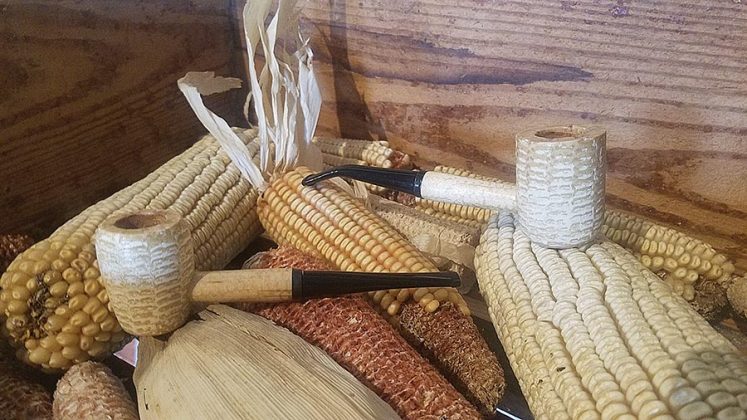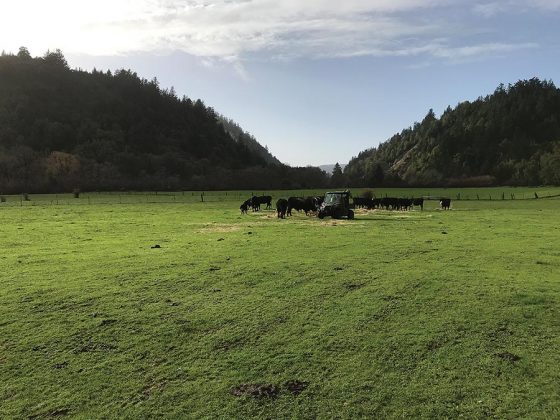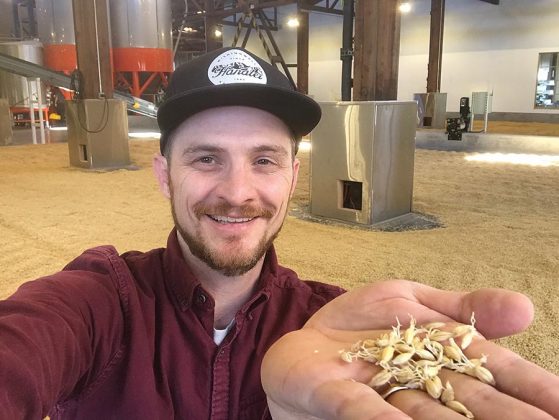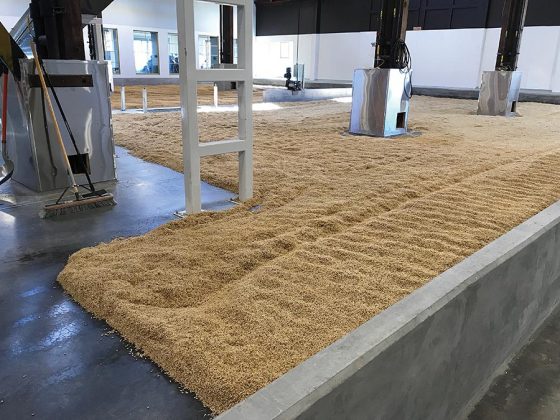Like a piece of weathered old hardwood furniture that’s been restored to its former glory, distillers are rediscovering heirloom grains and finding that they have character and story that commodity grain just can’t match.
Some distillers and farmers are focusing on grain from their region, while others are looking farther afield to find varieties that would be a good fit for their unique conditions. Pinckney Bend Distillery in Missouri has found a one-of-a-kind local source for the corn used in their white whiskey and their barrel-finished American whiskey. Just up the road from the distillery is the Missouri Meerschaum Company, the world’s largest and oldest corncob pipe producer. (Well-known users of Missouri Meerschaum pipes include Popeye the Sailor Man and General Douglas MacArthur.)
Pipe corn has been bred for 150 years to produce big cobs suitable for pipe-making, and the big, plump corn kernels were a waste product until the distillery reached out, according to Pinckney Bend Distiller and Chief Compliance Officer Keith Meyer. He said their master distiller drove past the cornfield one day and saw that the corn was different from what he saw everywhere else, and when he called them up, Missouri Meerschaum was happy to find someone who would use it.
Chief Operating Officer Tara Steffens said that, living in a wine-growing region, they understood the value of terroir and unique varietals but hadn’t known of anyone growing something different than the standard yellow dent corn. She said they started off with Reid’s yellow dent corn because “that’s what you can get,” and released the first batch of the pipe corn whiskey as an heirloom project. They started blending in the pipe corn with the yellow dent over several years and transitioned completely away from commodity corn three years ago.
“We were just so impressed,” she said, describing the pipe corn as fruitier than just a sweet corn, with some toffee sweetness. Meyer said yellow dent corn is so ubiquitous that “we don’t realize how much flavor we’ve actually bred out of it.” The flavor of the pipe corn “definitely comes through” in both their white and aged whiskeys.
“When you start using some of these heirloom corns, there’s a lot of character in them, because they’re not the right corn for making high-fructose corn syrup,” he said. “You get these different oil concentrations which are making it into the distillation. You’ve got different sugar quantities, different starch quantities, different oils. It drastically changes the flavor characteristics.”
Using the pipe corn in their unaged whiskey, “you get this beautiful intense corn note. It’s almost reminiscent of blanco tequila, but it has a lot of inherent sweetness,” he said. “When we (put) it in the 15-gallon barrels, it starts developing into this spicy, caramel-like aspect after it sits on the oak.”
Delineating heirloom versus heritage grain can be tricky. At a malt symposium in November 2018, Andrea Stanley of Valley Malt said 25 years was designated as the threshold for an heirloom variety. “Heirloom,” a term often used with vegetables such as tomatoes or squash, generally refers to varieties that are older and less industrial.
“‘Heirloom’ is a word that resonates with people, especially who have done a little gardening or have interest in local food,” she said. “They’re referring to a seed of a variety that’s been handed down, almost a cultural phenomenon.”
“Heritage” grain also includes older varieties that modern breeds have crowded out of the market, Stanley said. Maris Otter at one time was a widespread, industrial brewing variety, but as it’s been supplanted by more modern cultivars it’s moved more into the realm of a heritage malt.
Meanwhile, there is also “landrace” grain, which is bred traditionally through natural selection and farmers selecting for certain traits and evolves over time with the climate and local conditions. Stanley considers landrace to typically be a mixed-population, heterogeneous crop. Valley Malt sourced a Moravian landrace barley they call Hannah and now grow in Massachusetts.
Bill McDorman at the Rocky Mountain Seed Alliance described heirloom grains by comparing them to the furniture industry, where the term originated. “It’s a treasure, it’s something that we value,” he said. “Heritage grains are the ones that grew here before [agriculture] got big, when every area of the country had immigrant populations that brought grain from Europe.” As a result, there were local varietals, genetic “winners” all over the country.
He said the term “landrace” was originally coined by plant breeders after a Mendelian approach to genetics took hold at universities, a derogatory term breeders used that described the varieties that hadn’t been clinically bred and selected.
“Landraces is where we want to start. We want to see them for the treasures that they are,” he said. “They are the result of sometimes centuries of hard work by people who lived in a certain area.”
He listed three major differences between heritage grains and modern commodity grain: heritage grains are taller, they’re not as uniform, and they have not been “bred for bread,” i.e., they have varying protein levels, starch/sugar and color.
“Almost all modern commodity wheat has been worked on to increase production and make it good for white bread,” he said. As a result, flavor was deprioritized, and he said meta-studies have indicated that commodity grain also has less mineral content, and in some cases has lost specific amino acids. “Those were sacrifices to get high yield and something that was good for roller mills, but there were all sorts of other things that were left out.”
For Earl Brown of Wright & Brown Distilling in Oakland, CA, the rye that he uses in his bourbon and rye is his literal, tangible heritage. The rye is a varietal from the 1970s that’s grown on his family farm in Humboldt, and it’s part of a resurgence in California grain farming.
The grain-growing industry had largely died off in California by the middle of the 20th century, Brown said, but craft brewing, distilling and baking are driving a revival. In addition to their own farmed grain, Wright & Brown works with a couple of other farmers to source more standard grains and to experiment with older varieties, such as Abruzzi rye and Bere barley.
“It’s really about staying connected to the land and the farm that I grew up on and connecting that to what we’re doing at the distillery,” he said. “It’s fun experimentation. Hopefully some of it will turn into products that we can scale up.”
The flavor difference in heirloom grains, when chewed side-by-side with commodity grain, isn’t as noticeable, but “there are definitely big differences in the fresh distillate,” Brown said. Even barley that they grew, the standard varieties Conlin and Metcalf, tasted dramatically different — he described it as “a little bit of a floral, very grassy characteristic, almost hoppy” — when they sent it to be floor-malted at Admiral Malting in Alameda. Bourbon made from Bloody Butcher corn, while not finished aging, has a more buttery, oily taste and texture compared to yellow dent corn.
“What’s exciting about heirloom grains is making something with a unique flavor and style,” Brown said. “As a distillery, we take our ingredients and we manipulate the mashbill or process a little bit, and you have these pretty big changes in the final product. I believe that we’re going to get some unique flavor and style out of these grain varietals.”
Skagit Valley Malting is exploring those flavor differences in conjunction with local distilleries, including Copperworks Distilling and Westland Distillery. They have a number of products in barrels for four to five years or less, including single-varietal, single-estate single malt barrels at Copperworks and barrels of whiskey at Westland using malt smoked with peat from a bog in Washington state.
Skagit Valley has about 25 new varieties undergoing trials this year, including some from France, the Czech Republic and the UK, a Black Nile hull-less variety, and other hull-less, colored barleys from Oregon State University. Some are selected because they grow well in coastal climates like the Skagit Valley.
“It was commonly thought in the past that you couldn’t grow malt barley in these coastal climates because it’s not dry enough,” Green said, noting that their climate is similar to that of Scotland and the UK. “Some of the best malt in the world is grown in a cooler, damper climate.”
Another project they’ve been commissioned to undertake this year is to plant two batches of the same variety, one plot as close as possible to the saltwater near the mouth of the Skagit River, and the other plot upland to taste the impact of the saltwater climate.
“For us,” Green said, “it’s having the right partners that are very interested in this pursuit of terroir and flavor. Having those kinds of partners is exciting for us because they’re willing to dive in and be part of these tests.”
Several individuals noted that diversifying ingredients also helps to ensure food security. Stanley pointed to the Irish potato famine and the potential for other diseases to wipe out a specific variety of grain. “There’s nothing to do to help resist that monoculture’s susceptibility except to use chemicals, whereas landraces have a mixed population,” she said.
Growers and end-users also noted that older varietals require less “input” — water, fertilizer — and can be more pest-resistant. “In 1929,” McDormand said, “all the grains that were being grown were largely being grown without chemicals, because that was before the fertilizer or pesticide industries came up. They just adapted to where they are.”
By using unique ingredients and connecting more directly with farmers, distillers also create an opportunity to tell great stories about their products. Bill McDormand of the Rocky Mountain Seed Alliance said customers “want to know that you live here. It’s great marketing for people who are looking for something that’s not commodity.”
“You can add a level of authenticity — regional and historical authenticity — to your product by finding a grain, adopting it, learning how to grow it, and making a product that no one else has,” he said. “That’s what people are looking for, is a sense of place and terroir.”
There are challenges to working with nonstandard varieties, though. Sometimes heirloom crops need to be sequestered to keep from cross-pollinating an industrial crop, and the variability in size and shape that comes with such varieties can render modern harvesting machinery useless. Pinckney Bend has a variety of heirloom projects in barrels, releasing one per year. The corn varieties they’re using come in a variety of shapes — including a very thin variety with cherry/stonefruit tasting notes called Pencil Cob — with varying yields.
Whiskey distilled from Ohio Blue Clarage looked and smelled great, Steffens said, but the corn was apparently very appealing to the raccoons as well, so they only put up two 15 gal barrels of it. Meyer said they’ve learned that sometimes “it does take a little bit more of these heirloom corns to try to get the same amount of alcohol out the other side.”
In California, Brown pays three times the price of commodity grain for Bloody Butcher, hoping that covers the lower yield and higher level of risk to the grower. When working with farmers, he also prefers to “start with something that’s going to work, then you can work in some of these crops.”
Wright & Brown ferments on-grain, so to avoid the processing difficulty and potential tannic character that barley husks can bring, he’s growing test plots of hull-less barleys created by the botanist Luther Burbank, who developed the russet Burbank potato, among numerous other crops. The Bere variety of barley he’s working with is a thousand-year-old variety brought to Orkney Island by the Vikings and much later grown by settlers in the Pacific Northwest.
The first year, Brown received 125 seeds from a local seed company, which he grew in his yard at home and in the alley next to the distillery. He had 300,000 seeds after the next year, plotted it out again to propagate this year, and next year hopes to plant a few acres of it. It’s a well-suited variety for narrow coastal valleys, and he’s hoping that the combine they use can be adapted to harvest it. “If not, we’ll probably hand-harvest one round and we might not be able to keep doing it,” Brown said.
Meyer has also run into tight supplies for unusual seeds. “When we worked with some of these seed-saver groups, we got all the bulk seeds known in existence on the promise that we would propagate it and return some,” he said. Simply finding a source for very old varietals can be difficult; Pinckney Bend works with Seed Savers, the University of Missouri and the Missouri Botanical Gardens.
Sometimes they’re dependent on the amount of space that can be committed to higher-risk grain projects — 100 acres for Boone County white corn; 40 acres of sweet, maple-flavored Hickory Cane; down to as small as a 200-square-foot plot at the distillery.
At the Rocky Mountain Seed Alliance, one major goal is to scale up the supply and availability of these older grains, relying on volunteers to grow small plots and return some of their crop back to the alliance. For distillers, it can be an ideal way to see what grows well in their region and select the particular, unique grain that they want to grow and use.
“The amount of seed that was available for so many of our grains was so small, sometimes five grams, but with five grams we can scale up to tons in four or five years,” McDorman said. “You don’t necessarily need a farmer to start. Sometimes in the beginning it’s better to cast a wide net and have a gardener do it.”
For distillers who want to work with an organization like the Rocky Mountain Seed Alliance and join the grain trials they run, they recommend finding a grower and getting on the same page as far as the ideal type of grain, target specifications for protein, malting characteristics, and other production goals, then reaching out to find trials that might meet those needs.
“Once you figure out what you like and know a direction to go,” McDorman said, “you may say the emmers work better for you, or einkorn,” a wild grass that humanity started selecting 40,000 years ago. “I would drool if I walked into a place and someone had einkorn vodka.”












